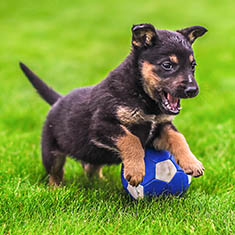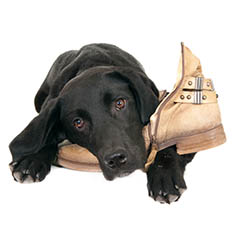What is Normal Puppy Development?
Most of us know that when puppies are born, they have their eyes closed and they don’t know where to go to the bathroom, but do you know anything else about how they grow and develop? If you don’t know what normal development is, it’s hard to tell when something is wrong.

Birth and infancy
After about 8 weeks in the womb, a puppy comes into the world inside an amniotic sac. The mother begins licking the puppy to break the sac and to stimulate the puppy to start breathing. Inside the womb, the puppy’s lungs didn’t have to work because oxygen from the mother’s bloodstream provided oxygen to all of the puppy’s body systems. However, as soon as the umbilical cord is cut, the puppy no longer has access to the mama dog’s cardiopulmonary system and must begin breathing on his or her own.
Once the puppy has been cleaned, he or she will generally find a way to the mama’s teats and start nursing. No one knows exactly how puppies find their way because until about 10 – 14 days of age, they cannot smell, hear, or see. It is possible to tell which puppies are going to have alpha personalities by watching where they feed. The teats in the center of the mama’s belly are generally considered prime real estate, and that’s where the alpha puppies will head. Less dominant puppies will get the teats at the top and bottom of the abdomen, while truly meek puppies will usually have to wait until the others are done eating.
Early vocalization
It takes about 3 weeks before a puppy will make much sound other than a whimper. Any loud cries should be immediately investigated because they likely mean the puppy is in distress. In large litters, some of the smaller puppies may not be getting enough feeding time because they are shoved aside by their larger brothers and sisters. Bigger puppies may also inadvertently hurt the smaller ones when they are playing, or the mama dog may sit down or roll over on a small puppy. So if you hear your puppy crying, you need to go check on him right away.
Transitional
Between two and four weeks of age, puppies begin to open their eyes, crawl around, bark, and wag their tails. They start realizing they have brothers and sisters, as well as a mama (a distinct creature, not just a source of nutrition). Their baby teeth begin to come in, and they are generally started on solid food at this time, although they will still nurse from their mother, too.
Childhood

From four to twelve weeks, puppies start to learn socialization. The puppies will begin to play with their littermates and learn how to “play bite”. They use these little nips to warn each other when play is getting too rough, but the bites are not intended to inflict pain.
Puppies can begin potty training at about five to eight weeks, and their mama may be their best teacher. Let them follow mama outdoors as often as possible, and they may begin to get some idea of what is expected of them. You can also confine them to a smallish area because they won’t want to mess up their sleeping area. If you keep them in a small area, then let them out frequently to relieve themselves, it will also help them to get the idea.
By eight weeks, puppies are usually fully weaned and can be sent to their forever homes.
By about twelve weeks, your dog should have been vaccinated against most easily-transmissable infection diseases and is ready to begin playing with other dogs. Socialization to other dogs is important because it can prevent your dog from being overly aggressive or overly fearful later in life. You should also socialize your dog to other household pets, including your children.
Growth
From four to six months, your dog’s primary job is to grow. It may seem that they add inches and pounds literally overnight. Although your new puppy will be very energetic, you will want to keep an eye on him or her to prevent rough play from injuring growing tissue. Joints are especially prone to injury, so you should try to keep your dog from jumping off anything too high up.
During this time period, your dog will also begin to try to figure out the social structure at your home. It is vital that you show the dog that you are the alpha member of the household and the he or she belongs well down the social ladder. Some things you will use to establish this pecking order include basic obedience training, and teaching your dog to do things only when you have given permission. For example, make the dog sit and stay before you put the food dish down. Allow the dog to get on couches and beds only after he or she has been invited. Feed the dog after the rest of the family has eaten. You must reinforce the fact that you are above the dog at every opportunity during these formative months, or you may struggle for supremacy for the remainder of the dog’s life. That may sound heartless and cold, but if your dog doesn’t understand that he or she must be subservient to you, it can cause major behavior problems later on.
Adolescence

From six to twelve months, your dog is going through his or her adolescent phase. Just as with human teenagers, this can be a difficult time to be a parent. Your dog is now big enough to cause real damage to your home or your children (particularly if you have a large breed), yet young enough not to understand that rowdy play might not always be appropriate.
Somewhere between one and two years old, your dog will reach social maturity and begin to settle down. For some dogs this maturity isn’t attained until as old as three years, but it will come eventually – don’t lose heart! Just keep working with your dog until he or she learns you are the boss and in charge of all the good things in life.
For more information:
- Dumb Friends League - Developmental Stages of Puppy Behavior
- The Puppy Portal - Seven Stages of Puppy Development
- Diamonds in the Rough - Developmental Stages and Socialization
- Doggies.com - Newborn Puppy Care
One final note
One of the biggest reasons why dogs are abandoned to shelters is because the dog doesn’t match the owner’s expectations. Spend some time thinking about what you want out of a dog, and research the various breeds to match your lifestyle and expectations to the breed’s expected temperament. Realize that your puppy will take a long time to mature, so be patient and continue with socialization and training to get the dog you desire.
Doggies Den: Latest Articles
 Homemade Thanksgiving Treats for Your Dog
Homemade Thanksgiving Treats for Your Dog
NUTRITION We all want to include our dogs in our holiday celebrations, but hopefully, you're aware that sharing table scraps with your dog isn't always the best idea.
 Keeping Your Dog Safe during the Summer Months
Keeping Your Dog Safe during the Summer Months
HEALTH Summer is coming on fast, so it’s time to plan how you will keep your dog safe and healthy through the lazy, carefree, warm days.
 Vaccination Time Again-Keeping Your Puppy Healthy
Vaccination Time Again-Keeping Your Puppy Healthy
DOG HEALTH So you have your new puppy picked out. There are quite a few shots, treatments and examinations that will keep the newest member of your family healthy.
 Canine Thanksgiving Feast
Canine Thanksgiving Feast
NUTRITION With the wide variety of food at Thanksgiving dinner, chances are you'll want to give your dog something special, too. If you're contemplating what to feed your dog for the holiday, here is a guide to a great Canine Thanksgiving Feast.
 Dog Walking Tips Every Owner Should Know
Dog Walking Tips Every Owner Should Know
DOG FUN Walking your dog is not only crucial to keeping him healthy and happy, it strengthens the bond between your canine friend and his caregiver. There are a lot of obstacles out there. Don’t forget these simple tips to keep your walk fun and safe in the outside world.
 The Benefits of Physiotherapy for your Dog
The Benefits of Physiotherapy for your Dog
HEALTH The same techniques that physiotherapists use to treat a variety of injuries and conditions in humans have been adapted to suit animals with great success. Family pets, show dogs, and working dogs can all benefit greatly from physiotherapy. Dogs whose activities involve a lot of agility are especially susceptible to the types of problems that physiotherapy can address.
 The Decision- Adding a Dog to Your Family
The Decision- Adding a Dog to Your Family
FIRST TIME OWNERSBringing a dog into your family is a decision where many people don’t realize it’s magnitude until after they have the dog. There are a number of things that you need to research before you decide to purchase a dog, and it starts right in your own home.
 Bringing Your Dog Into Your New Baby's Life
Bringing Your Dog Into Your New Baby's Life
HEALTH Many believe that a dog and a new baby cannot happily coexist, so therefore the dog has to go. This is not necessarily the case.  A new baby does not mean you have to abandon your dog.

Doggies Den:
Most Popular Articles

Dog Pregnancy Symptoms
HEALTHIf you suspect your dog might be pregnant, check out part one in this series on pregnant dogs, where we cover pregnant dog symptoms.

Dog Birth
HEALTHIn the third article of our dog pregnancy series, we look at the wonderful, but messy, process of bringing newborn puppies into the world.

Indoor Dog Potties
DOG PRODUCTSIt's been a long day at work. You were so busy, you didn't even take time to eat a sandwich, let alone run home to let your dog out. You're on your way home, knowing the poor dog is crossing his or her legs by now, when your car breaks down, delaying you even further. Can't somebody make this easier?

Your Dog’s Digestive System
PHYSIOLOGYEver wonder why your dog eats so fast? Or why he eats gross things? Or why he gets sick to his stomach? Or why his waste stinks so bad? Some of these things are normal, some are not.

Canine Respiratory System
BREATHINGThe basic function of your dog's respiratory system is to bring oxygen in to and remove carbon dioxide from the body. Knowing the symptoms of respiratory diseases can help you help your stay healthy.

Shelter Dog Adoption Tips for Success
ADOPTION Are you intimidated by the prospect of "rescuing" a dog from a shelter? One reason that you may be wary of adopting a dog from a shelter is not knowing how to choose. Adopting a dog from a shelter can be a rewarding process, if you're prepared to do a reasonable amount of research.

Canine Urinary Tract Infections
SYMPTOMS AND TREATMENTDoes your dog seem to be having trouble relieving his or her bladder? Learn how to recognize the signs of urinary tract infections and how to treat them before they spread.

What to do for Dog Diarrhea
SYMPTOMS AND REMEDIESIf you have dogs in your house for any length of time, you have likely experienced at least one bout of dog diarrhea. Beyond the pain in the tuckus involved in cleaning up the mess, you should know what causes diarrhea, and when it's important to see the vet.

What to do for a Dog Bite
DOG BEHAVIOR Getting bitten by a dog can be scary, and you may be tempted to run around in circles for a while, trying to figure out what to do. Here's our guide to help you manage the situation.

Top Ten Tips for Living with a Senior Dog
DOG HEALTH Bringing home a new puppy is so exciting, but it doesn’t take all that long for your exuberant puppy to grow into a senior dog who may have special needs. Here are the doggies.com top ten tips for taking care of your companion who has been with you through so much.
